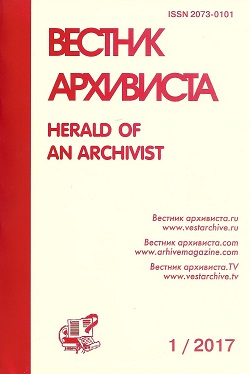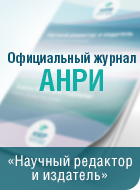УДК 314.02+908:930.253
DOI 10.28995/2073-0101-2017-4-23-36
Natalia D. Borschik
Crimean Federal University, Simferopol, Russian Federation
Problems and Prospects of Studying the Tavrida Gubernia of Late 18th – Early 20th century
Abstract
The article offers a brief description of the first descriptions of the Crimean peninsula, executed both in pursuance of the central authorities decrees (for example, the Cameral Description of the Crimea in 1784), and on the personal initiative of Russian scientists, public figures, amateur enthusiasts. Quantitative data of these and many similar studies, circumstances of their compilation, source-specific features, possibility of usage, representativity, etc. has remained outside the sphere of researchers’ interest. The article attempts to systematize the available sources of statistical descriptions of the Taurida gubernia of late 19th - early 20th century and outline the prospects of their study. The significance of the scientific conceptualization of historical experience of regions description is associated with crucial role of quantitative information in public administration. By late 19th century Russia had become a powerful state with imperial status, which naturally required a progressive development of its statistical descriptions: numerical data were among key factors of national security, economic welfare, tax revenues, social stability, state of culture, etc. Repeated attempts to reform the statistical agencies did not result in any qualitative changes in state statistics of the Russian Empire, whence it follows that regional authorities, local self-government, non-governmental institutions (societies), ministries and departments, and public had to be involved in the statistical surveys. Results of these numerous descriptions, quite different in their aims and tasks, methodology of their conducting, and practice of using them today are a most valuable source of information on population, economic and cultural development of the regions of pre-revolutionary Russia. The practical importance of researching the materials of these descriptions is obvious: when comparing the data of national statistical activities and the regional surveys, it is possible to resolve questions about the degree of completeness and reliability of the results obtained. Numerical results allow to identify and to assess changes occurred since the previous survey, and the knowledge of these dynamics becomes a basis for short- and long-term social forecasts. The surviving archival materials bear testimony to numerous statistical descriptions of population, land, property, etc., carried out by the local self-government bodies ‘for local needs.’ Most informative are fonds of religious institutions of the multi-confessional Crimea, which made their own descriptions of parishioners, priests, etc.
Download the article: borschik_doi
Keywords
Historical and statistical sources, population process, Russian Empire, Tavrida gubernia of the 19th century, statistical descriptions
References
BORSCHIK, N. D. Naselenie Kurskogo kraya v XVIII — XIX vv.: po materialam tserkovnoi statistiki [Population of the Kursk region in the 18th -19th century on church statistics. In Russ]. IN: Vestnik Tomskogo gosudarstvennogo universiteta [Bulletin of Tomsk State University], 2009, no. 324, pp. 169-174.
BORSCHIK, N. D. Uchet naseleniya Kurskoi gubernii ofitserami Generalnogo Shtaba v seredine XIX v. [Census registration in the Kursk gubernia by the General Staff officers in mid-19th century. In Russ]. IN: Voenno-istoricheskiy zhurnal, 2008, no.12, .рр. 21-24.
VODARSKII, YA. E. Naselenie Rossii v kontse XVII — nachale XVIII v.: Chislennost, soslovno-klassovyi sostav, razmeschenie [Population of Russia in late 17th – early 18th century: Population figures, class composition, distribution. In Russ]. Moscow, 1977, 263 p.
VODARSKII, YA. E., ELISEEVA, O. I., KABUZAN, V. M. Naselenie Kryima v kontse XVII — kontse XX veka. (chislennost, razmeschenie, etnicheskii sostav) [The Crimea population in the late 17th – early 20th century: Population size, location, ethnic composition. In Russ]. Moscow, 2003, 160 p.
VOLFSON, B. Prisoedinenie Kryma k Rossii v 1783 godu [Accession of the Crimea to Russia in 1783. In Russ]. IN: Istoricheskii zhurnal, no. 3, 1941, рр. 56-67.
GABLITS, K. I. Fizicheskoe opisanie Tavricheskoi oblasti, po ee mestopolozheniyu, i po vsem trem tsarstvam prirody [Physical description of the Taurida region by its location and all three kingdoms of nature. In Russ.]. St. Petersburg, Typ. I. Veitbrekhta publ., 1785, 199 p.
GULEVICH, V. Ulug Ulus (Krymskoe khanstvo) [Ulug Ulus (Crimean Khanate). In Russ.]. IN: Zolotaya Orda v mirovoi istorii. Kollektivnaya monografiya [The Golden Horde in the world history: A collective monograph]. Kazan, Institut istorii im. Sh. Mardzhani AN RT publ., 2016, pp. 761-777.
KABUZAN, V. M. Izmeneniya v razmeschenii naseleniya Rossii v XVIII — pervoy polovine XIX v.: Po materialam revizii [Changes in the distribution of population in Russia of the 18th - first half of the 19th century: Based on the census materials. In Russ]. Moscow, 1971, 190 p.
LASHKOV, F. F. Kameralnoe opisanie Kryima, 1784 g. [Cameral description of the Crimea in 1784. In Russ.] IN: Izvestiya Tavricheskoi uchenoi arkhivnoy komissii. T. 2 [Proceedings of the Tavrida scientific commission]. Simferopol, 1897, pp. 20-33.
LASHKOV, F. F. Shagin-Girey poslednii krymskii khan: Istoricheskii ocherk [Shahin Girai, the last Crimean Khan: Historical essay. In Russ.] Kiev, 1886, 48 p.
MIRONOV, B. N. Russkii gorod v 1740—1860-e gg.: demograficheskoe, sotsialnoe i ekonomicheskoe razvitie [Russian town in the 1740s-1860s: Demographic, social and economic development. In Russ]. Leningrad, 1990, 271 p.
NEPOMNYASCHII, A. A. Pervaya nauchnaya sistematizatsiya krymskikh drevnostei. Istoriya sozdaniya i sud’ba sobiratelya P.I. Kyoppena [The first scientific systematization of the Crimean antiquities: The history of creation and the fate of the collector P.I. Koppen. In Russ.]. IN: Istoricheskoe nasledie Kryma: Sb. statei [Historical heritage of the Crimea: Collected articles]. Simferopol, Gosudarstvennyi komitet po okhrane kul'turnogo naslediya Respubliki Krym publ., 2016, pp. 164-177.
PALLAS, P. S. Kratkoe fizicheskoe i topograficheskoe opisanie Tavricheskoi oblasti, sochinennoe na frantsuzskom yazyke Petrom Pallasom... i perevedennoe Ivanom Rizhskim [A brief physical and topographic description of the Taurida region, compiled in French by Peter Pallas, and translated by Ivan Rizhsky. In Russ.]. St. Petersburg, Imp. typ. publ., 1795, 72 p.
RAZDORSKII, A. I. Krym: istoriya v bibliografii [The Crimea: History in bibliography. In Russ]. IN: Mir bibliografii, 2003, no. 1, рр. 61-62.
About author
Natalia Dmitrievna Borschik, PhD in History, V.I. Vernadsky Crimean Federal University, Taurida Academy, document and archival science department, professor, Simferopol, Russian Federation Simferopol, Russian Federation, +7-910-211-86-00, This e-mail address is being protected from spambots. You need JavaScript enabled to view it
Grant information
The research has been supported by the Development Program of the Federal State Autonomous Educational Institution of Higher Education ‘V.I. Vernadsky Crimean Federal University’ for 2015—2024 in the framework of the implementation of academic mobility under the project of Federal State Autonomous Educational Institution of Higher Education ‘V.I. Vernadsky Crimean Federal University’ ‘Support of academic mobility of the University employees on demand.’
Submitted 4.06.2017, published:
BORSHCHIK, N. D. Problemy i perspektivy izucheniya opisanii Tavricheskoi gubernii kontsa XVIII — nachala XX v. [Problems and prospects of studying the Tavrida gubernia of late 18th – early 20th century. In Russ.]. IN: Vestnik arhivista – Herald of an Archivist, 2017, no. 4, pp. 23-36.














